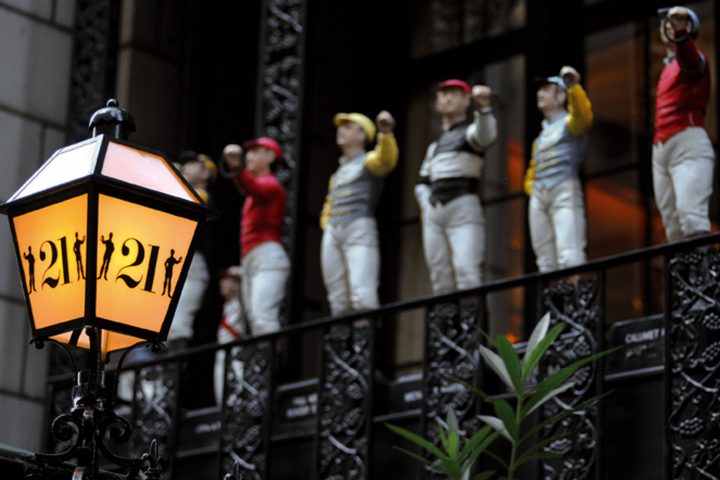
A Triple Crown winner -- and a local artist -- is adding new lustre to the jockeys now standing guard outside NYC's classic '21' Club.
Read the original article on the NY Post here...
On a 94-degree day this July, a heist appeared to happen in broad daylight on West 52nd Street.
One by one, 36 colorful iron lawn jockeys were yanked from their spots outside the iconic ‘21’ Club, where they guarded the doors to the dining room of the city’s cultural, political and business elite.
As six foremen spent four sweaty hours lugging the statues into a moving truck — the smallest jockeys on the stairs weigh 50 pounds, while the largest near the entrance top 200 — they attracted not only scores of passers-by, but the attention of New York’s Finest.
“The NYPD slowed down [to ask] the mover what the heck was going on,” Andrew Tedesco, 45, says.
The jockeys were headed to Tedesco’s home in Montclair, NJ, where the artist is currently putting the finishing touches on an eight-week, major refurbishment of them — marking the first time in the club’s 85-year history that the little iron men have been missing from its facade.
Another first? The addition of a Zayat Stables jockey to commemorate American Pharoah’s Triple Crown win on June 6 — the first American horse to do it in 37 years.
Like victorious jockey Victor Espinoza, the new statue will sport a blue-and-yellow polka-dotted silk — a “Z” emblazoned on its chest and back — when it makes its debut outside ‘21’ next month.
“I watched [the Belmont Stakes] with my family, and we were all cheering for a Triple Crown winner,” says Tedesco. The win fortuitously coincided with the already planned restoration, and the club decided to paint an existing jockey statue in honor of Zayat Stables as part of the revamp.
“We’ve been fortunate enough to welcome Zayat Stables [to the club], as well as the trainer for American Pharoah and Victor Espinoza, the very famous jockey himself,” says ‘21’ Club’s marketing director, Avery Fletcher. Historically, iron jockeys were placed in front yards for guests to tie up a horse — hence the weight — or to hang a lantern. But when entrepreneur, sportsman and club regular J. Blan van Urk donated the first statue at ‘21’ in the early ’30s, it simply stood for his love of the spot, where he hung out with Humphrey Bogart and sports journalist Howard Cosell.
Eventually, 36 jockeys decorated the facade of ‘21,’ most donated by patrons who were horse enthusiasts or stable honors. Over they years, they attracted a layer of soot. When Tedesco got them to his home, he started by washing the statues, then “sanding [them] like crazy to get all the chunks of paint off.”
Still, crafting just one pair of eyes on a jockey took two hours, as Tedesco had to work with mismatched eyelids and pupils.
“They were sculpted by an iron guy, not an artist. They’re very asymmetrical. When you start painting, [one eye might be] hardly there and the other bulging. They get creepy.”
Tedesco, a muralist who’s painted for Samuel L. Jackson and Spike Lee, first started taking on projects at ‘21’ in 1994, as a fresh art-studio grad from the University of Maryland. He began by revamping the paintings in the private rooms upstairs. Then, 19 years ago, he was asked to touch up the jockeys — without moving them from the club.
“I was literally standing on the stairs painting upside down,” says Tedesco, laughing. “So this time, it’s completely ideal for me. The paint is actually curing properly . . . and I put the gloss on so the New York City grime will just wash off like a rain repellent.”
After stripping the statues of their original paint, Tedesco re-envisioned the jockey’s silks, opting to make them more historically accurate, with brighter hues. “I talked to LeRoy Neiman, who donated tons of paintings to the ‘21’ Club, and he said, ‘When I go to the racetrack, the thing that hits me are the flashing colors,’ ” Tedesco says of the late artist, who passed away in 2012.
“So that’s why it was really important to do the research on the silks and make sure they’re right.”
At one point, the Sugar Tree Farm jockey was completely wronged. The statue was repainted to match the restaurant’s colors in 1995. This was particularly egregious because it was the Club’s first-ever statue, donated by van Urk.
When Tedesco learned of this anomaly, he “felt so bad. It was his inspiration that started the whole awesome trend.” This summer, Tedesco restored van Urk’s statue to its original colors — maroon and gray — 17 years after the death of its owner.
Tedesco is making other changes, too.
When they return, the stair-bound jockeys will face the street — not the entrance —making their slick new name tags visible to passers-by. “I found a picture from when they were doing a Bette Davis movie [“All About Eve”], and all the jockeys on the stairs were facing the street,” Tedesco says. “So I sent it to ‘21’ and told them I want to turn them around.”
Since the jockeys’ disappearance on July 20, ‘21’ general manager Teddy Suric says he’s received numerous calls from people eager to know when “the jockeys are coming home.” When they do return in mid-October — carefully wrapped in blankets — they’ll be finished works of art, with new LED lighting to help them pop even more on the street.
“They really are the DNA to the place,” says Suric, who commissioned the revamp as part of his efforts to revitalize the club. “And it’s just night and day what [Tedesco’s] doing to them. They’ve deteriorated for so long outside with the weather.”
The club plans to have a celebration when the jockeys come home and the Zayat statue is unveiled.
While the Zayat family can’t make the induction ceremony for their new jockey, 23-year-old racing manager Justin Zayat says he plans to visit next time he’s in the city.
“This is all because of one horse — American Pharoah,” Zayat says. “To have the jockey be added to the club, it’s a big honor, and we’re proud to be a part of it.”









